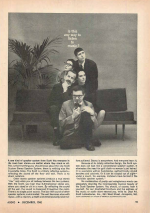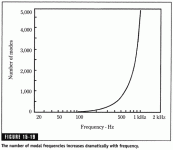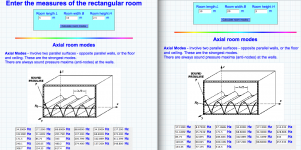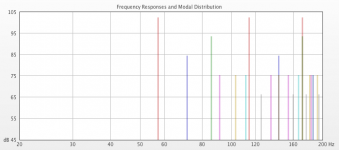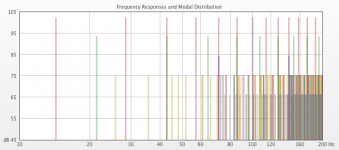In small room it easy to get dense and intense sound field that is just too loud for hearing system. Threshold differs between individuals, and overload level tends to decrease with age. Somewhere on the borderline it just takes adding one reflective surface just a little too close, and its off into overload land.
My days of loud shows where you can't even hear person next to you screaming when they are more than six inches away are long behind me. Somewhere in that once upon a time I had loud car system; on the highway to hear low level detail in classical music I would put in 22dB plugs, and turn up the volume.
My days of loud shows where you can't even hear person next to you screaming when they are more than six inches away are long behind me. Somewhere in that once upon a time I had loud car system; on the highway to hear low level detail in classical music I would put in 22dB plugs, and turn up the volume.
To me, the magic of the human hearing system is that it's capable of attenuating the intense peaks in just such a way that subtle detail is still perceivable. Go right next to a live brass band when it fires up and experience this: the instruments create intense pressure peaks constantly, yet the full decay of little details a split-second later will still register clearly; the human ear is in full flight, processing a tremendous dynamic range so that it all makes sense, there is little loss of satisfying musical information. For me that's the goal of a good system, to be able to present the same quality of soundscape for the ear/brain to enjoy travelling through ...
This thread has become very uninteresting!
I disagree and Elias with the Annapolis Elecroacoustic Corp. made it even more interesting!
I understand. But in my experience the levels of real and recorded instruments differ in what you can stand in a small room. Of course some of that has to do with the playback system's limits, but not all (I think). Usually live doesn't sound as loud to me as recorded, even at the same or higher SPLs. It seems to me that the combo of small room acoustics and recorded acoustics causes part of the trouble.-- I have a grandson who played a kit in a tiny practice area at one stage, and this was truly 'immersive' sound, your whole being was swimming in the intensity of the acoustic bombardment - I love it!
Might be worthwhile to test that idea with very dry or anechoic recordings.
Small rooms develop standing waves at much higher frequencies than large rooms.
True.
Not true. The smaller the room the more standing waves are "eliminated" at the lower end.
The number of modes within a room always increases with frequency:
(Everest "Master Handbook of Acoustics")
Attachments
Originally Posted by vacuphile
Small rooms develop standing waves at much higher frequencies than large rooms.
Room modes calculator calculate 3 modes - rectangular room control room eigenmodes eigenfrequencies standing waves room acoustic node frequency - sengpielaudio Sengpiel Berlin
Small rooms develop standing waves at much higher frequencies than large rooms.
The lowest room modes decrease in frequency as the size is increased.Not true. The smaller the room the more standing waves are "eliminated" at the lower end.
The number of modes within a room always increases with frequency:
Room modes calculator calculate 3 modes - rectangular room control room eigenmodes eigenfrequencies standing waves room acoustic node frequency - sengpielaudio Sengpiel Berlin
Attachments
You've touched on a key point here. My experience has been that the subjective "loudness" varies dramatically as the quality of the playback varies; which I believe is due to the ear/brain adapting to the combination of SPL and spectrum content it's experiencing. The AGC system in one's head tries to reach a good optimum for what it's hearing, and IME when it finds the sound easy to digest - minimum distortion - then the AGC works at it's best. As an example, with top notch sound happening, one can be in the far end of one's home, and the playback will sound house filling, dynamically alive; and then one can walk towards the speakers and literally put your ear right next to the drivers without touching the volume -- and in a subjective sense the volume doesn't appear to grow enormously doing this, rather the sound registers subjectively as being very intense at the highest SPL position.I understand. But in my experience the levels of real and recorded instruments differ in what you can stand in a small room. Of course some of that has to do with the playback system's limits, but not all (I think). Usually live doesn't sound as loud to me as recorded, even at the same or higher SPLs. It seems to me that the combo of small room acoustics and recorded acoustics causes part of the trouble.
Might be worthwhile to test that idea with very dry or anechoic recordings.
Originally Posted by vacuphile
Small rooms develop standing waves at much higher frequencies than large rooms.
The lowest room modes decrease in frequency as the size is increased.
Room modes calculator calculate 3 modes - rectangular room control room eigenmodes eigenfrequencies standing waves room acoustic node frequency - sengpielaudio Sengpiel Berlin
Correct. Just wanted to point out that large rooms have modes at high frequencies just like small rooms. Perceptual problems arise when the modal distribution becomes sparse which happens at the low end of the frequency spectrum. The larger the room the more this range of sparse modes is shifted downwards.
Simulated modes in a room of 3m x 2m x 2.4m:
Simulated modes in a room of 12m x 8m x 2.4m:
Attachments
Not true. The smaller the room the more standing waves are "eliminated" at the lower end.
The number of modes within a room always increases with frequency:
(Everest "Master Handbook of Acoustics")
You are a remarkeable guy since you disagree with me even if you agree with me.
One further remark: the number of room modes will increase with increasing frequency, but their intensity will diminish. The combined effect is that in a small room, room modes are higher in frequency than in large rooms. You really think you can have a 1KHz standing wave in a 1000 m3 hall? No, of course not, but you can have it in your bathroom.
You are a remarkeable guy since you disagree with me even if you agree with me.
Your original post sounded not right - at least to me
You really think you can have a 1KHz standing wave in a 1000 m3 hall? No, of course not, but you can have it in your bathroom.
You can. It's the modes that make sound "travel".
Any room, if sufficiently reflective will support standing waves at virtually any frequency.
Smaller the room, the higher the frequency that will exhibit uni-modal behavior. Energy just doesn't disappear because the room got smaller.
Radiator much smaller than wavelength with this wavelength greater than longest room dimension brings spherical harmonics into play.
Smaller the room, the higher the frequency that will exhibit uni-modal behavior. Energy just doesn't disappear because the room got smaller.
Radiator much smaller than wavelength with this wavelength greater than longest room dimension brings spherical harmonics into play.
You can. It's the modes that make sound "travel".
You appear to lack a fundamental understanding of the way sound propagates through air. It is of course not the modes that make sound "travel".
Before posting, you might consider to Google the basics first. Just willing to be helpful here: https://en.wikipedia.org/wiki/Sound.
One more note on standing waves in large rooms/ small rooms:
Handbook for sound engineers, Ballou, second edition, p. 45: the boundary between region A (dominated by normal modes) and region B (dominated by diffraction and diffusion) occurs at a frequency of f Hz, which may be estimated from the following emperical equation: f= 11250sqrt(T/V), with T the reverberation time in seconds and V the volume of the room in cubic feet. As you can see, when V goes up, f goes down. At p.46 of this standard work, this is represented in a graphical way which I shall not copy for copyright reasons.
You appear to lack a fundamental understanding of the way sound propagates through air. It is of course not the modes that make sound "travel".
I guess Earl needs some tutoring too
http://www.diyaudio.com/forums/mult...-pattern-stereo-speakers-214.html#post2935941
I guess Earl needs some tutoring too
http://www.diyaudio.com/forums/mult...-pattern-stereo-speakers-214.html#post2935941
So you also do not understand Earl. Compound misunderstandings are unfortunately not like double negations in that they do not lead to anything positive.
- Home
- Loudspeakers
- Multi-Way
- The Advantages of Floor Coupled Up-Firing Speakers
